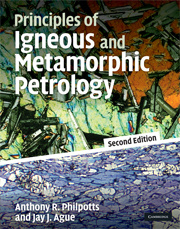Book contents
- Frontmatter
- Contents
- Preface
- Acknowledgments
- List of units
- 1 Introduction
- 2 Physical properties of magma
- 3 Intrusion of magma
- 4 Forms of igneous bodies
- 5 Cooling of igneous bodies and other diffusion processes
- 6 Classification of igneous rocks
- 7 Introduction to thermodynamics
- 8 Free energy and phase equilibria
- 9 Thermodynamics of solutions
- 10 Phase equilibria in igneous systems
- 11 Effects of volatiles on melt equilibria
- 12 Crystal growth
- 13 Isotope geochemistry related to petrology
- 14 Magmatic processes
- 15 Igneous rock associations
- 16 Metamorphism and metamorphic facies
- 17 Deformation and textures of metamorphic rocks
- 18 Graphical analysis of metamorphic mineral assemblages
- 19 Geothermometry, geobarometry, and mineral reactions among solid solutions
- 20 Mineral reactions involving H2O and CO2
- 21 Material transport during metamorphism
- 22 Pressure–temperature–time paths and heat transfer during metamorphism
- 23 Origin of rocks
- Answers to selected numerical problems
- References
- Index
17 - Deformation and textures of metamorphic rocks
- Frontmatter
- Contents
- Preface
- Acknowledgments
- List of units
- 1 Introduction
- 2 Physical properties of magma
- 3 Intrusion of magma
- 4 Forms of igneous bodies
- 5 Cooling of igneous bodies and other diffusion processes
- 6 Classification of igneous rocks
- 7 Introduction to thermodynamics
- 8 Free energy and phase equilibria
- 9 Thermodynamics of solutions
- 10 Phase equilibria in igneous systems
- 11 Effects of volatiles on melt equilibria
- 12 Crystal growth
- 13 Isotope geochemistry related to petrology
- 14 Magmatic processes
- 15 Igneous rock associations
- 16 Metamorphism and metamorphic facies
- 17 Deformation and textures of metamorphic rocks
- 18 Graphical analysis of metamorphic mineral assemblages
- 19 Geothermometry, geobarometry, and mineral reactions among solid solutions
- 20 Mineral reactions involving H2O and CO2
- 21 Material transport during metamorphism
- 22 Pressure–temperature–time paths and heat transfer during metamorphism
- 23 Origin of rocks
- Answers to selected numerical problems
- References
- Index
Summary
INTRODUCTION
The mineralogical composition of a metamorphic rock can be used to determine pressures, temperatures, and fluid compositions during metamorphism. But this is only part of the record these rocks preserve. Their textures are also a source of valuable information and in most cases are diagnostic of a particular type of metamorphism – contact versus regional, for example. Textures are important in working out the timing of metamorphic events, especially in regionally metamorphosed rocks. Indeed, the interpretation of metamorphic textures is an important part of structural geology and some books have been devoted entirely to this topic. Only a brief introduction can be given here, but for more detailed coverage reference can be made to texts by Turner and Weiss (1963), Spry (1969), Hobbs et al. (1976), Suppe (1985), Passchier and Trouw (1996) and Vernon and Clarke (2008).
Many of the textures in metamorphic rocks result from the recrystallization of existing minerals or the growth of new ones. The general principles governing these processes were dealt with in Chapter 12, but little attention was given to the effects of deformation, other than to indicate that strain energies provide an additional driving force for recrystallization. Regional metamorphism is normally accompanied, at some stage in its development, by strong deformation, which results in the formation of a number of characteristic textures. It is these textures with which this chapter is mainly concerned. Brittle deformation involves fracturing at the grain scale or larger, whereas ductile or plastic deformation proceeds without fracturing.
- Type
- Chapter
- Information
- Principles of Igneous and Metamorphic Petrology , pp. 428 - 446Publisher: Cambridge University PressPrint publication year: 2009



